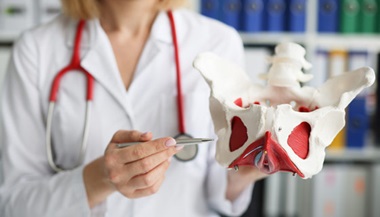Sonohysterography
What is sonohysterography?
Sonohysterography, also called a saline infusion sonogram (SIS) or sonohysterogram, is a procedure to look at the inside of the uterus. It’s a safe test that uses sound waves and a computer to create images. It does not use radiation.
The uterus (womb) is the organ where a baby grows during pregnancy. The bottom of the uterus is called the cervix. This is the opening into the uterus. The cervix sits at the top of the vagina.
During a sonohysterography, you’ll be awake and lying down with your knees bent. A slim wand called an ultrasound transducer is placed in your vagina. This wand is covered with a disposable sheath and coated with a special gel.
A clinician will then insert a thin, flexible tube (catheter) into your cervix. A salty fluid called saline is sent through the catheter into your uterus. At the same time, the transducer sends sound waves through the gel and into your body. The echoes from these sound waves create a real-time image of the inside of your uterus that shows the structure of your uterus. The saline fluid helps the ultrasound form an image with sharper detail.
In addition to providing your doctor with important information about the uterus and ovaries, a sonohysterogram can help to determine if the fallopian tubes are open, to determine if there are any ovarian cysts and to measure your antral follicle count, which is a measure of the egg supply.
Why might I need sonohysterography?
Health care practitioners use sonohysterography to help diagnose a number of medical conditions, including:
- Uterine fibroids
- Uterine polyps
- Scarring inside the uterus
- Abnormal shape of the uterus
- Uterine cancer
Your doctor might advise this test if you have symptoms that suggest a problem with your uterus, such as:
- Abnormal menstrual bleeding
- Infertility
- Repeated miscarriages
- An abnormal pelvic exam
You might need this test if a standard ultrasound test doesn’t show enough information to diagnose a problem.
Sonohysterography has some benefits over other tests used to get information about the uterus. Other tests include:
- Hysterosalpingography: This is a type of X-ray that uses radiation.
- Hysteroscopy: This surgical procedure is done with anesthesia.
- MRI: This imaging test is done with large magnets and a computer. An MRI may not give as clear a picture of the inside of the uterus.
What are the risks for sonohysterography?
Sonohysterography is a safe procedure with few risks. Some women feel discomfort during the procedure and may experience cramping during and after the procedure. In very rare cases, there is a small risk of pelvic infection. Your health care practitioner will take steps to help prevent this.
Women who have active pelvic inflammatory disease (PID) should not have the procedure. Your doctor might advise a pregnancy test prior to the procedure. This is to avoid any possible risk to a growing baby. Pregnant women should not have a saline sonohysterography exam.
Talk with your doctor to find out what risks may apply to you.
How do I prepare for sonohysterography?
- It’s best to have the procedure in the week after your period ends. This will help the test be more accurate. It will also lower your risk of infection.
- You can eat and drink as normal on the day of your procedure. You will likely be able to take all your medicines as normal.
- Your doctor may advise taking an over-the-counter pain medicine ahead of time to help prevent discomfort.
- You may be told to take an antibiotic before the test to help prevent infection.
- You may want to wear an absorbent pad in your underwear on the day of the procedure. This is because saline fluid will drain from the uterus after the procedure.
Your doctor may give you more instructions about how to prepare.
What happens during sonohysterography?
The test is done at a physician’s office or at a hospital. A technician or a radiologist may do the procedure. A radiologist is a doctor who specializes in using imaging methods to diagnose and treat diseases. The test usually lasts less than 30 minutes. You can generally expect the following:
- Before the procedure starts, you’ll need to empty your bladder. You’ll then undress from the waist down, and lie on an exam table. You will be awake and alert for the test. You may experience cramping during and after the procedure.
- Your doctor may first give you a pelvic exam to check for any pain.
- A clinician will cover the transducer wand with a thin sheath and a special gel. The wand will then be put into your vagina.
- The clinician may move the wand slightly to get different images of your uterus. These images appear on a video screen. This is a standard vaginal ultrasound.
- After taking these images, the clinician will take the transducer out.
- He or she will then insert a speculum into your vagina. This is the same device used in a standard vaginal exam. This helps keeps the vagina open so the practitioner can see and reach your cervix.
- The clinician may use a swab to wipe and clean your cervix.
- Next, a thin catheter will be put into the opening of your cervix. You may feel pinching or cramping as the catheter is inserted. The speculum will then be removed from your vagina.
- The clinician then puts the wand back into your vagina. Saline will be sent through the catheter, through the cervix and into the uterus. This may cause some cramping. When enough saline fluid fills your uterus, images are taken of the inside of your uterus.
- After the images are taken, the clinician removes the wand and catheter. The saline fluid will drain out of your uterus over the next few hours.
What happens after a sonohysterography?
You will likely be able to go home right after your procedure. In most cases, you can resume normal activities right away. The saline fluid will drain out of your uterus over the next few hours.
For a little while after the procedure, you might have symptoms like:
- Cramping
- Light spotting
- Fluid leaking from your vagina
These are all normal. Most women do not have pain after the procedure. If you do, you can take over-the-counter pain medicine.
Let your doctor know right away if you have severe pain or fever in the next few days. Also, let your doctor know if there is a change in the type or amount of your vaginal discharge. These might be signs of an infection. Your doctor may give you more instructions.
After the exam, a radiologist will look at the images and send a report to your primary care physician. Talk over these results with your doctor. The results may confirm a health condition that needs treatment. You may need another test, such as a hysteroscopy. Your doctor can tell you more.
Next steps
Before you agree to the test or the procedure, make sure you know:
- The name of the test or procedure
- The reason you are having the test or procedure
- What results to expect and what they mean
- The risks and benefits of the test or procedure
- What the possible side effects or complications are
- When and where you are to have the test or procedure
- Who will do the test or procedure and what that person’s qualifications are
- What would happen if you did not have the test or procedure
- Any alternative tests or procedures to think about
- When and how you will get the results
- Who to call after the test or procedure if you have questions or problems
- How much you will have to pay for the test or procedure

.jpg?h=500&iar=0&mh=500&mw=1300&w=1297&hash=F8BB9DA427823EB29EDF019A6635000F)




